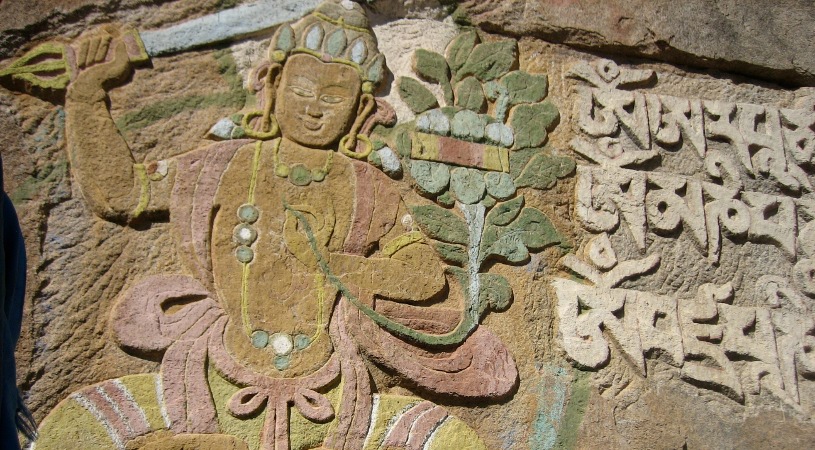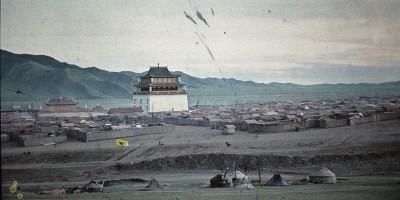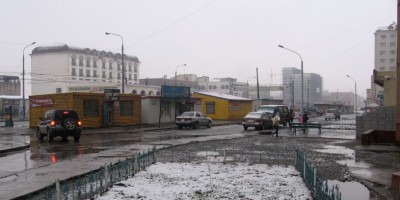A recent article written by Michael Kohn for Reuters about the removal of the Lenin statue in front the Ulaanbaatar hotel contained a quote from the current Ulaanbaatar mayor Mr. Bat-Uul that caught my attention. He said, “We lost around 40,000 people in just two years during the 1930s. They were killed in cold blood. It was genocide.”1 It’s the number that piqued my interest. The estimates for how many people died in the purges that occurred from 1937 to 1939 are really all over the map from as low as 22,000 people to as high as 100,000 people.2 Somewhere in that range is the actual death toll. Was Mr. Bat-Uul actually on the mark?

Horloogiyn Choibolson
The reason for asking this is not a morbid curiosity in genocide. Although, from the perspective of understanding power and politics in human society, it is hard not to be drawn to these extreme examples of quite literally everything going wrong. An engaging read on the topic is Samantha Power’s “A Problem from Hell: America and The Age of Genocide” which describes the anatomy of genocides in the 20th century against Armenians, European Jews, Cambodians, Iraqi Kurds, Rwandan Tutsis, and Bosnians, the social and political repercussions afterwards, and the practical and moral dilemmas those events posed for American diplomacy. A take away of that book for me is the difference between genocide and something else occurring, such as a protracted civil war, appears to be completely random. It might be reassuring to think that genocide only happens in places where it is easy to identify a trait of the society or individuals within the society as abnormal, thereby making a genocide seem inevitable, but the historical evidence doesn’t support that idea. It is more like cancer. A perfectly functioning cell suddenly turns cancerous, and its advantage is that the rest of the body doesn’t see the change as dangerous until it is far too late. Even cells that would normally defend the body against dangerous pathogens can be fooled into assisting the cancer by enabling its progression or by simply ignoring it. The lesson of genocide in part has been genocide can happen anywhere, it unfolds before everyone’s eyes, and it is difficult to know with absolute truth who is responsible, prominent authority figures like Hitler, Pol Pot, or Mongolia’s own Choibolson not withstanding. Think of the famous quote “First they came for the [some group]…I said nothing…Then they came for me, and there was no one left to speak.”3
The inherent complexity of genocide makes the aftermath extremely challenging to societies. Perpetrators of the violence can argue victim-hood and those who did nothing to can be labeled as complicit. Perpetrators may have just been following orders, those who did nothing may have used circumstances to settle old scores, and both groups may even make up some portion of those murdered. This makes understanding the past and reconciliation difficult. History seems to have shown a mixed bag in terms of reconciliation. For example, the genocide of the Armenians is not a topic of conversation you should generally bring up with a Turk unless you are looking for an argument, but Germans have gone to great pains at least publicly to absolve the sins of the past.
The anthropologist Christoper Kaplonski has a superb paper on the history and social and political impact of the purges in Mongolia.4 (I recommend grabbing the paper from the footnotes if you want a more thorough analysis). One area that he examines is the development in the late 1990s of using the purges as a wedge issue in Mongolian politics. The Democratic Party (DP) coalition used their dominance in parliament from 1996-2000 to bring the purges to the political forefront, and as Dr. Kaplonski points out, it is hard to argue this was not in part politically motivated.
The Mongolian People’s Revolutionary Party (MPRP) was nominally the party that oversaw the purges and the MPRP was (and is) also the DP’s main political rival. As cynical as it sounds, attempting to make the “genocide” label stick to your opponent seems like a obvious political tactic if circumstances allow. In America, it is a tactic shamelessly used by partisans all the time. I think there are more pictures on the Internet of George W. Bush and Barack Obama with Hitler mustaches than pictures of Hitler himself. I am not sure this tactic is effective in US politics, but in Mongolia it seems to have been somewhat effective. I recall once attending an investors conference in which a high ranking MPRP official in his presentation about the current political state of Mongolia griped about the DP’s and other opposition parties’ insistence on labeling the MPRP as the party of genocide and oppression. He said something to the affect, “We’re all Mongolians. Our party members were victims, too.” And, leading up to the 2012 elections the MPRP changed its name to the Mongolian People’s Party (MPP) undoubtedly to blunt the DP’s future use of the victim-taking-on-his-oppressors theme in their political rhetoric.
Mr. Bat-Uul is a senior member of the DP and was one of the young revolutionaries that helped usher in the democratic era. As such, taking the cynical view again, he does have a political interest in making the death toll of the purges higher. The numbers are bad enough without inflation. According to the National Statistics Office, the population was approximately 738,200 in 1935, and would have been around 748,000 based on annualized growth rates in 1937 when the mass killings began.5 Even at the low end estimate of 22,000 people murdered, that would have been 2.9 percent of the population. A significant loss of life.
Yet, if you compare it to a much larger event in history such as the genocide in Cambodia, it pales in comparison. In both relative and absolute terms, Cambodia is shocking with 1.7 million people or 21 percent of the population killed over four years.6 When playing the genocide card, you have to make sure your example fits people’s understanding of what genocide is, which is based on the standards sadly set in places like Cambodia. In other words, if the purges are an effective wedge issue, then making it more horrific makes it a better instrument.
Dr. Kaplonski offers a variety of estimates from different sources for the total number of victims of the purges, and the title of the paper “30,000 Bullets” splits the difference between the low end estimate and Bat-Uul’s estimate. Surprisingly to me all estimates seem to rely on educated guesses. There seems to be a lack of official documentation to zero in on the true number.
The National Statistics Office has census data for 1918, 1935, and 1944.7 If you take the annualized change in population from 1918-1935, Mongolia was adding approximately 5,335 people per year. From 1935-1944, the annualized rate dropped to 2,320 for a difference of just over 3,000 fewer people per year. If you make the simple assumption that all of that loss was attributed to the purges, then you could claim a total loss of 27,000 people by summing the annual rate over nine years. This doesn’t prove Bat-Uul wrong per se, but it does provide further evidence that estimates greater than 30,000 may be inflated.
So coming back to why Mr. Bat-Uul’s number piqued my interest is that historical tragedies are tragic enough without trying to use those events to score political points against opponents. Being skeptical of simple histories with good vs. evil themes is important in a democratic society, and having accurate information is important in analyzing complicated histories. We may never know how many people were actually killed in the purges nor who ultimately bears a share of the responsibility along with the government of the 1930s lead by Choibolson and his allies, but we shouldn’t let politics dictate what we know in the absence of hard facts. The evidence available suggests Mr. Bat-Uul’s number is inflated, and the history is complicated enough without exaggeration and political hyperbole. Moreover, the total number is not nearly as important as remembering the actual people who died and the fact that all Mongolians were effected by it–not just those who label themselves as “democratic.” As Dr. Kaplonski writes, it is hard to find a family today that doesn’t have at least one relative in the past who was a victim of the purges. By that same token, given the size of Mongolia’s population it is probably also as hard to find a family that doesn’t have at least one relative in the past who was somehow complicit in the violence. What is certain, however, is that no one alive today in politics actually was a victim or a perpetrator. It may be an obvious political tactic to try to make the “genocide” label stick to your opponent if the opportunity is there, but it is also not right if one is honest about the complexity of history.
Footnotes
1. Michael Kohn, “Capitalist Mongolia bids not so fond farewell to Bolshevik Lenin”, http://www.reuters.com/article/2012/10/10/us-mongolia-lenin-idUSBRE89904B20121010, (October 10, 2012).
2. For a breakdown of the different estimates and their sources, see Christopher Kaplonski, “Thirty Thousand Bullets: Remembering Political Repression in Mongolia”, in Historical Injustice and Democratic Transition in Eastern Asia and Northern Europe (2002), http://www.chriskaplonski.com/downloads/bullets.pdf.
3. See the Martin-Niemoller-Stiftung Foundation website: http://www.martin-niemoeller-stiftung.de/4/daszitat/a31.
4. Christopher Kaplonski, “Thirty Thousand Bullets: Remembering Political Repression in Mongolia”, in Historical Injustice and Democratic Transition in Eastern Asia and Northern Europe (2002), http://www.chriskaplonski.com/downloads/bullets.pdf.
5. National Statistics Office, “2010 Census Main Results”, http://www.toollogo2010.mn/doc/Main%20results_20110615_to%20EZBH_for%20print.pdf, slide 5
6. Yale University, “Cambodian Genocide Project”, http://www.yale.edu/cgp/.
7. National Statistics Office, “2010 Census Main Results”, http://www.toollogo2010.mn/doc/Main%20results_20110615_to%20EZBH_for%20print.pdf, slide 5.



